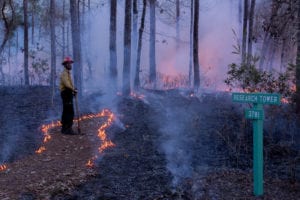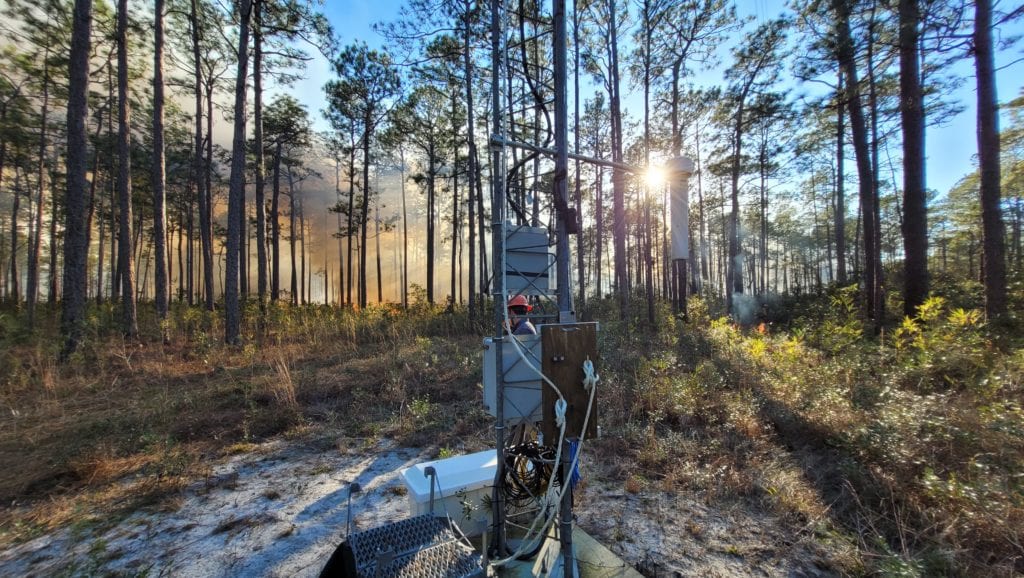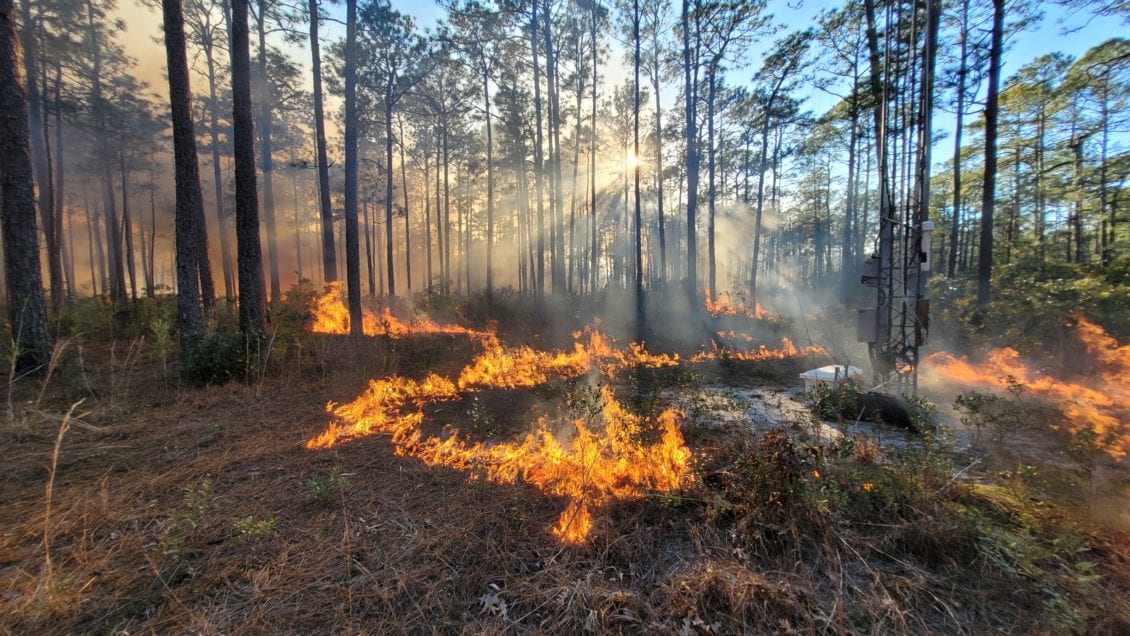A Clemson University team is using a 120-foot research tower located deep within a forest in the Lowcountry to study carbon and water cycling in longleaf pines and what benefits longleaf forests contribute to the environment.
In partnership with The Nature Conservancy (TNC), Tom O’Halloran, Marzieh Motallebi and Bo Song’s research aims to provide new valuable data and landowner options to contribute to the decade-long effort to restore longleaf across the historic range. This project is supported by a grant from the National Fish and Wildlife Foundation (NFWF) and funding from International Paper.
“To start, it’s really just to answer those basic questions: How does a longleaf pine forest sequester carbon? How does it cycle water? And TNC is interested in that because they’re working on natural climate solutions and interested in carbon sequestration projects — using forests to take carbon out of the atmosphere — and so they really wanted to study the dynamics of that system,” O’Halloran said.
O’Halloran, an assistant professor in Clemson’s Forestry and Environmental Conservation Department, has made it his mission to decipher the rhythmic, cyclical “conversations” between the land surface and the atmosphere of our world to better understand how and why they are connected. He climbs into the sky on four towers scattered around the Lowcountry to listen. These days, he also treks to the quietest, most isolated parts of the wetlands, towing a customized trailer full of cutting-edge equipment to eavesdrop.
The research will be conducted on Hobcaw Barony property — a 16,000-acre research reserve owned by the Belle W. Baruch Foundation and located on the coast near Georgetown, S.C., where Clemson maintains its Baruch Institute of Coastal Ecology and Forest Science (BICEFS). BICEFS is one of six Clemson Research and Education Centers located throughout the state.
“The Baruch Foundation and TNC are doing a great job managing these forests with prescribed fire,” O’Halloran said. “That has created a wonderful research opportunity for us right in our backyard.”
O’Halloran already has used his tower to collect about three years of data on carbon and water sequestration from the longleaf forest; now, following a recent burn, the measurements will continue to study the effects of the prescribed burn on the forest.
NFWF and TNC support the restoration of longleaf pine forests because these efforts benefit many native species — including the iconic red-cockaded woodpecker — that call those forests home, according to O’Halloran
The pilot project will utilize measurements of the rate of ecosystem carbon sequestration in a newly restored longleaf pine plantation and mature longleaf habitat to gain a better understanding of the connection with longleaf habitat components and carbon sequestration. This new data in conjunction with existing studies will be reviewed and used to inform landowners and partners.
In a project funded by the S.C. Natural Resources Conservation Service, Motallebi, Song and doctoral student Lucas Clay studied how various forest management practices can change carbon stocks by looking at various forest types in different locations in South Carolina.

In a published article resulting from that study, “An Analysis of Common Forest Management Practices for Carbon Sequestration in South Carolina,” a variety of management practices were employed to see the variance in carbon sequestration. Results showed that carbon sequestration would increase for certain management practices such as thinning and prescribed fire, while clear cutting over time was harmful to sequestration.
TNC Longleaf Pine Whole System Director Colette DeGarady, the principal investigator on the project, said that for 10 years, there has been a concerted effort in the southeast to restore native longleaf forests and the great biodiversity these habitats contain.
“As climate issues are increasingly discussed and solutions to reduce negative climate impacts are being sought, it’s important to understand what native longleaf forests can bring to climate solutions,” DeGarady said. “This project will help provide information on how newly planted, appropriately managed, and long-lived longleaf pine stands factor into carbon sequestration and water yield. The engagement between TNC and Clemson on this project will lead to beneficial distribution of that information to landowners and conservation partners.”
Increasing awareness of climate impacts coupled with corporate interest in supporting sustainability provides vast opportunities for carbon markets. The research proposes to help make deeper connections with longleaf pine, carbon capture and landowner education in order to facilitate an increased desire to plant longleaf by private landowners resulting in more acreage on private lands.
Twenty-five landowners will also take part in a workshop to better inform how they can manage healthy longleaf stands and how that fits into the current carbon market, with the goal of helping landowners realize the link to building healthy longleaf forests and how they might benefit financially with carbon markets. Additionally, TNC will plant 200 acres of longleaf pine through its Plant a Billion Tree program to restore native forests and capture carbon.
Using his research towers and other tools, O’Halloran measures the emissions of gases like methane, carbon dioxide and nitrous oxide released by the soil and ways with advanced sensors housed in the mobile lab. Nitrous oxide and methane, particularly, can strongly influence the climate.
Better understanding the soil’s role in releasing these gases can help landowners increase profitability and help public policymakers manage land and mitigate greenhouse gas emissions. O’Halloran and his collaborators can use the data collected to, for example, valuate carbon credits in coastal wetlands and conservation easements on restored rice fields, or to understand how sea-level rise is affecting coastal ecosystems.
From the towers, which are stationed around BICEFS, O’Halloran measures the exchange of carbon, water and energy between the Earth’s surface and the atmosphere. He works with a team of international scientists to create a global map measuring the cooling effect forests have by regulating the exchange of water and energy between the Earth’s surface and the atmosphere, potentially a valuable tool in efforts to mitigate climate change.

Get in touch and we will connect you with the author or another expert.
Or email us at news@clemson.edu

